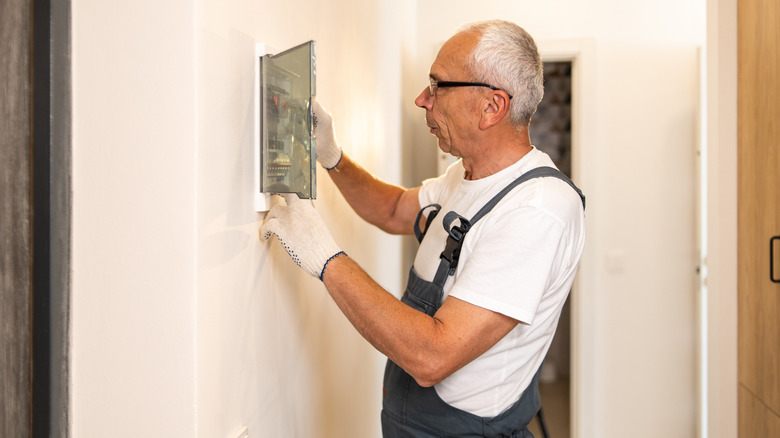Use A Simple Curtain Trick To Cover The Eyesore Of An Electrical Box
Here's something that's never happened: Your guest returns from the washroom and offers her hand in an unexpected goodbye. "I'm sorry, Mildred," she says, "but I have discovered your secret without even trying, and I can't bring myself to ignore your blatant use of circuit breakers." Not a lot of people would be surprised that you have overcurrent protection for your home wiring, or that it resides in a circuit breaker box. Yet we've seen many dozens — perhaps hundreds — of ways to hide a breaker panel, as if burying a dark family secret. The most recent of these, and perhaps the easiest, is to simply cover the panel with a curtain. But it does get a bit more complicated than that.
Some breaker box concealment tricks require carpentry, like building a cabinet to hide your electrical panel. Others require skills ranging from wallpapering to painting on canvas. Hanging a curtain, though, is probably a skill you've already mastered, because windows. For the same reason, a curtain in the middle of a wall will often escape the conscious notice of your visitors, who are likely to simply process it as another window ... albeit a strangely dark one. Of course, you could mix it up and put fabric on a frame or, in a fit of overkill, line the entire wall with curtains. But all that's really required is that you cover the breaker panel, perhaps with drapery the same size as used elsewhere in the room to keep it from standing out. Of course, there are creative window coverings that aren't curtains or shades, and they might also work.
Staying code-compliant
The National Fire Protection Association has a few things to say about breaker panels, and even though simply covering it probably won't require a permit or inspections, it's a good idea to conform to code requirements. There's nothing particularly onerous here — just some guidance that might inform your choices. The key relevant codes include the requirement that circuit breakers remain readily accessible. They should also be located "not in the vicinity of easily ignitable materials, such as in clothes closets." And, finally, you should follow any manufacturer's guidelines for your particular breaker box, as well as any common sense rules that apply to most or all electrical devices, like not insulating it to the point of causing heat buildup.
The need for ready accessibility seems to mean that you can't let curtains or anything else get in the way of using the breaker panel. Stick to drapery that can't be closed in the breaker box door — perhaps ones that are sufficiently taller and wider than the box so that they won't get caught up in the opening when you close it. It might also make sense to use a curtain hanging mechanism that will allow you to move them completely out of the way, like swing-out arms, traverse curtain rods, wrap-around rods, and magnetic rods. It's probably also a good idea to use fire-resistant curtains like those that have passed the National Fire Protection Association's (NFPA) 701 test by virtue of the fabric's characteristics or by being treated with a flame-retardant finish.

